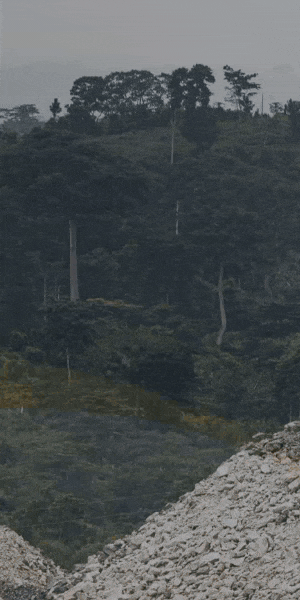Cabral Gold Delivers High-Grade Results at PDM Target as $45M Financing Propels Brazilian Gold Project Forward

Cabral Gold reports 23.3m at 4.7 g/t gold from PDM target drilling while advancing construction of Stage 1 heap leach operation following recent US$45M gold loan financing.
- Cabral Gold has released new drill results from the PDM target at its Cuiu Cuiu gold project in Brazil, reporting a headline intercept of 23.3 meters at 4.7 grams per tonne gold from 57 meters depth, including high-grade intervals of 1 meter at 91.3 g/t gold and 1.1 meters at 8.1 g/t gold.
- The company recently secured a US$45 million gold loan to finance construction of its Stage 1 gold-in-oxide heap leach starter operation, representing a significant milestone in advancing the project toward production.
- The PDM target represents a strong gold-in-soil anomaly located 2.5 kilometers northwest of the Central gold deposit, with historical placer gold mining activity indicating significant mineralization potential in the area.
- The newly intercepted mineralized zone appears to correlate with previous drilling 100 meters to the northwest that returned 8.5 meters at 5.1 g/t gold, suggesting continuity of mineralization that remains open down dip and along strike.
- Drilling continues at multiple targets including Machichie Main, Machichie NE, and the Mutum target, with additional exploration results expected in coming weeks alongside construction updates for the Phase 1 starter operation.
Cabral Gold Inc. is a Canadian junior exploration and development company focused on advancing its wholly-owned Cuiu Cuiu gold project in the Tapajós region of northern Brazil. The company is progressing toward gold production through a staged development approach, with its Stage 1 gold-in-oxide heap leach operation financed by a recently secured US$45 million gold loan. Cabral Gold maintains an active exploration program targeting expansion of hard rock resources across multiple high-priority targets within the Cuiu Cuiu property.
The latest drill results from the PDM target demonstrate the continued exploration potential at Cuiu Cuiu while the company advances its near-term production plans. For investors evaluating Cabral Gold, the combination of project financing, construction progress toward production, and ongoing resource expansion through exploration represents a dual-track value proposition balancing near-term development milestones with longer-term discovery potential.
Project Context & Financing Milestone
Cabral Gold recently announced a transformational financing arrangement that positions the company to advance its Cuiu Cuiu project toward production. The US$45 million gold loan will finance construction of the Stage 1 gold-in-oxide heap leach starter operation, representing what management characterized as "probably the most important press release in the company's history."
The financing structure allows Cabral Gold to maintain its exploration drilling program while simultaneously advancing construction activities. This dual approach reflects management's strategy to develop near-term cash flow from oxide mineralization while systematically expanding the understanding of larger hard rock resources that could support longer-term mining operations.
The Cuiu Cuiu gold project is located in the Tapajós region of northern Brazil, a prolific gold district with extensive historical artisanal mining activity. The property covers a significant land package with multiple exploration targets at various stages of evaluation and resource definition.
PDM Target: Geological Setting & Historical Significance
The PDM target represents a compelling exploration opportunity within the broader Cuiu Cuiu project area. According to management commentary:
"The PDM target is a very strong gold-in-soil anomaly which is located 2.5km NW of the Central gold deposit. Significant amounts of placer gold were mined historically from the streams draining both the Central gold deposit and the PDM target."
The presence of extensive historical placer mining activity provides important geological context for the current drilling program. Placer gold deposits form through erosion and concentration of gold from primary hard rock sources, indicating that substantial gold mineralization exists in the bedrock underlying the PDM target area. The streams draining both the Central deposit and PDM target produced significant placer gold, suggesting strong source mineralization in both areas.
Currently, PDM lacks a defined hard rock resource due to insufficient drilling density. The ongoing exploration program aims to systematically test the subsurface geology and define the extent and grade of mineralization beneath the gold-in-soil anomaly. Recent work has successfully expanded the understanding of near-surface gold-in-oxide mineralization at PDM, as referenced in a September 25, 2025 press release, providing confidence that significant mineralization exists in the area.
Latest Drill Results & Geological Interpretation
The headline result from the current drilling program comes from drill hole DDH346, which intersected 23.3 meters at 4.7 grams per tonne gold from 57 meters depth in hard rock. Within this broader mineralized interval, high-grade zones include 1 meter at 91.3 g/t gold and 1.1 meters at 8.1 g/t gold.
Management provided geological context for this intercept, noting:
"This appears to be the same mineralized zone previously intercepted in drilling previously completed 100m to the NW which returned 8.5m @ 5.1 g/t gold including 0.7m @ 30.4 g/t gold, and is one of four mineralized zones thus far identified in fresh intrusive rocks below the gold-in-oxide blanket at PDM."
The apparent continuity of mineralization over a 100-meter strike length represents an important geological observation. The correlation between DDH346 and previous drilling suggests the presence of a coherent mineralized system rather than isolated occurrences. The identification of four separate mineralized zones within fresh intrusive rocks beneath the oxide blanket indicates structural or lithological controls on gold deposition that may extend across a larger area.
The geological model emerging from drilling at PDM shows gold mineralization hosted in intrusive rocks beneath a near-surface oxide zone. This geological architecture is common in orogenic gold systems, where repeated phases of deformation and fluid flow can create multiple stacked or parallel mineralized zones. The presence of high-grade intervals within broader zones of lower-grade mineralization suggests variable gold concentration processes, potentially related to structural controls such as fracturing, shearing, or changes in rock competency.
Exploration Potential & Resource Expansion Opportunities
The mineralized zone intersected in DDH346 remains open in multiple directions, providing clear targets for follow-up drilling. Management noted:
"The mineralized zone intersected in DDH346 remains open down dip and along strike to the SE and to the NW."
Open extensions along strike and down dip represent priority targets for resource expansion. Strike length and vertical extent are critical parameters for determining the economic potential of a gold deposit, as they directly influence the tonnage of mineralization that can be defined and potentially extracted. The current drilling has tested only a limited portion of the broader PDM target area, leaving substantial ground for systematic exploration.
Management expressed optimism about the resource potential at PDM based on recent results: "Having recently demonstrated that the near-surface gold-in-oxide blanket at PDM is significantly larger than we originally thought (see press release dated September 25, 2025), we expect more results in the underlying intrusive rocks. This should auger well for the presence of a significant underlying hard rock gold resource at PDM."
The expansion of the oxide blanket footprint provides an important exploration indicator. Gold-in-oxide mineralization forms through weathering and oxidation of primary sulfide mineralization in bedrock. A larger oxide footprint suggests a correspondingly larger underlying hard rock source, supporting management's expectations for a significant hard rock resource at depth. The relationship between surface geochemistry, oxide mineralization, and underlying hard rock gold systems is well-established in tropical weathering environments similar to northern Brazil.
Ongoing Exploration Activities
Cabral Gold maintains an active drilling program across multiple targets within the Cuiu Cuiu project area. Beyond PDM, the company is advancing exploration at Machichie Main, Machichie NE, and the Mutum target. The Mutum target is located 500 meters southeast of PDM, suggesting potential connectivity or similar geological controls between these areas.
Management indicated that results from these ongoing programs will be released in the near term:
"Drilling is continuing at Machichie Main and Machiche NE, and also at the Mutum target which is located 500m SE of the PDM target, so expect more exploration drill results in the coming weeks, as well as news regarding our progress on the construction of the Phase 1 starter operation."
The simultaneous advancement of exploration and construction activities demonstrates Cabral Gold's commitment to maintaining exploration momentum while progressing toward production. This approach allows the company to continue defining resources that could support expanded operations beyond the initial Stage 1 heap leach facility.
The proximity of multiple targets within the Cuiu Cuiu property creates potential synergies for future mining operations. If multiple deposits can be defined within trucking distance of a central processing facility, the company could develop a hub-and-spoke mining operation that improves project economics through shared infrastructure and optimized ore blending.
Development Timeline & Near-Term Catalysts
Cabral Gold faces a critical period as it advances both exploration and development activities. The recent financing provides the capital necessary to construct the Stage 1 heap leach operation, positioning the company to generate cash flow from oxide mineralization while continuing to explore for larger hard rock resources.
Near-term catalysts for investors include construction progress updates on the Phase 1 starter operation, additional exploration results from ongoing drilling at PDM and other targets, and potential resource estimate updates incorporating recent drilling. The transition from pure exploration to development and production represents a significant de-risking event, particularly as the company demonstrates its ability to execute construction and commissioning activities.
The exploration results from PDM and other targets will influence longer-term planning for expanded operations beyond the initial heap leach facility. Definition of substantial hard rock resources could support feasibility studies for conventional milling operations with higher throughput capacity, potentially transforming the scale and economics of the Cuiu Cuiu project.
For Investors
Cabral Gold's latest drill results from the PDM target demonstrate continued exploration success at the Cuiu Cuiu gold project, with high-grade intercepts indicating the presence of significant hard rock mineralization beneath the expanding oxide blanket. The headline intercept of 23.3 meters at 4.7 g/t gold in DDH346 shows apparent continuity with previous drilling and remains open for expansion, supporting management's expectation for a significant underlying hard rock resource.
For investors evaluating Cabral Gold, the company presents a development opportunity advancing toward near-term production through the US$45 million financed Stage 1 heap leach operation, while maintaining an active exploration program targeting resource expansion across multiple high-priority targets. The combination of project financing, construction advancement, ongoing exploration success, and a portfolio of drill-ready targets provides multiple potential value drivers over the coming months. The successful delivery of construction milestones and continued positive exploration results from PDM, Machichie, and Mutum targets will be key factors in assessing the company's ability to execute its dual strategy of near-term production and longer-term resource growth at the Cuiu Cuiu gold project in Brazil.
Analyst's Notes




Subscribe to Our Channel
Stay Informed



































